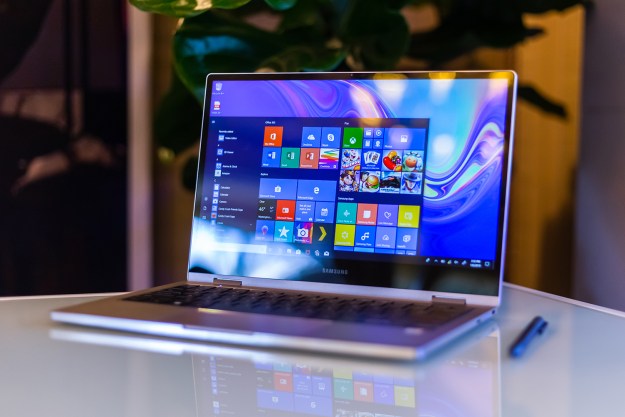
“The Notebook 9 Pro brings Samsung laptops into the modern age.”
- Solid, aluminum build quality
- Trimmed bezels
- Redesigned stylus writes comfortably
- Lighter, thinner design
- Upgraded processor and storage
- Keyboard feels cheap
- Touchpad doesn’t track well
- No Windows Hello support
Samsung has enjoyed endless success in categories like television and smartphones, but its laptops are a different story – in the United States, at least. They’ve always felt a bit cheap. The Notebook 9 Pro, debuted at CES 2019, is the company’s most recent attempt to solve that problem.
More from CES 2019
- Razer Raptor 27 hands-on review
- Sennheiser says you have to hear its new Ambeo soundbar to believe it
- One of the coolest things at CES 2019 is a block of wood
The NoteBook 9 Pro isn’t the company’s flagship device — that’s the Notebook 9 Pen with its S Pen. The Pro is more a middle-of-the-road laptop, something that can compete head-to-head with the Dell XPS 13 or MacBook Air. With the addition of a new active stylus and a redesigned chassis, can the Notebook 9 Pro be a proper alternative to Apple’s latest?
New pen, new paper
Unlike in prior years, the NoteBook 9 Pro has just one size option, a 13.3-inch version. The 15-incher is now only an option in the Notebook 9 Pen line. What the Notebook 9 Pro does have, though, is style. Compared to the Pen, the Pro has a much more premium feel, completely constructed out of a rigid, aluminum chassis. Along both the lid and the base are diamond-cut edges, which provide a unique texture for your fingers. It’s almost like jewelry.

It’s not just for looks. The device also feels substantially more rigid and well-built than in previous years. That was a problem we had with past Samsung
Change has come to the stylus, too. Samsung is famous for its investment in stylus tech, but the S Pen that was housed and included with previous Notebook 9 2-in-1s is no more. The new stylus is a thicker, active pen in the vein of the Apple Pencil or Surface Pen. While it’s no longer housed in the chassis (and must be powered by a battery), this new pen feels more comfortable to hold. Samsung says it hasn’t lost any functionality and offers over 4,000 levels of sensitivity. Our short time with the stylus affirmed those claims.
The Notebook 9 Pro starts with a Core i7-8565U processor, which is Intel’s latest and greatest.
The screen itself has thinner bezels, but is still a standard 1080p display, capable of up to 350 nits. In fact, the entirety of the device has cut back on weight and thickness. It’s now 2.84 pounds and 0.55 inches thick. It’s not as insanely light as last year’s Notebook 9 Pen (2.2 pounds), but it’s a much-need reduction from last year’s Pro model. It still doesn’t feel quite lite enough to be used comfortably as at tablet, but occasional usage will work well.
Port selection has also modernized, removing the USB-A ports and replacing them with USB-C. In particular, the Notebook 9 Pro comes with two Thunderbolt 3 ports, a standard USB-C port, and a microSD card slot. That’s a good fit for this notebook, which is intended to be a highly-mobile, 2-in-1 device.
The one aspect of the device we wish Samsung had spent more time on was the keyboard and touchpad. The keyboard has been redesigned, but it still feels a bit chintzy. The travel isn’t overly short, but the bottoming out action feels hollow. The touchpad has some similarly cheap vibes, not quite tracking as well as on other
Upgrades across the board
The Notebook 9 Pro starts with a Core i7-8565U processor, which is Intel’s latest and greatest. It’s a quad-core processor which, combined with 8GB of RAM, should be a great productivity machine capable of some serious performance. The notebook also comes with 256GB of NVMe PCIe SSD storage. That’s another step up from last year’s model, which used a SATA SSD with slower read and write speeds.
Samsung also claims the updated device will last longer on a single charge, though its battery has only increase from a 54 watt-hour to a 55 watt-hour unit.
The Notebook 9 Pro doesn’t have a firm price or release date yet. As of now, all we know is that it will be available in “early 2019.” The price of last year’s 13-inch model was $1,100, so we can assume it will be somewhere in that ballpark.
Editors' Recommendations
- 9 best laptops of 2024: tested and reviewed
- The XPS 16 is fighting an uphill battle against the MacBook Pro
- Why one of my favorite laptops still struggles against the MacBook Pro
- The 4 best Samsung laptops for work and play in 2024
- HP takes on Alienware and Samsung with its 4K QD-OLED gaming monitor


